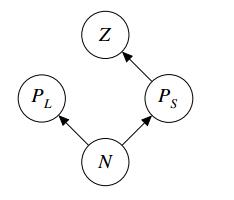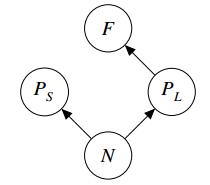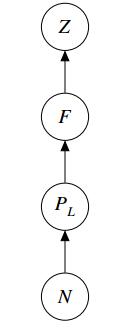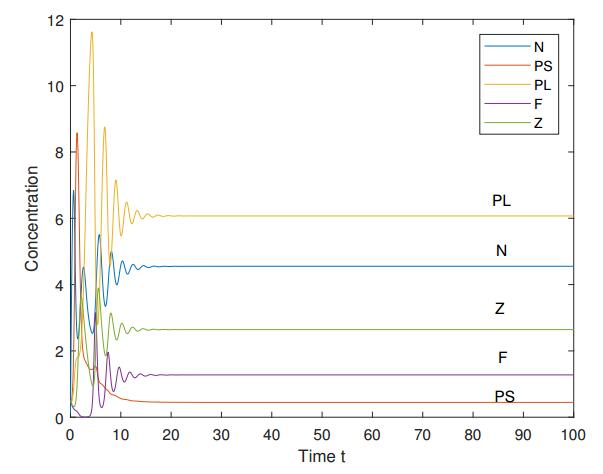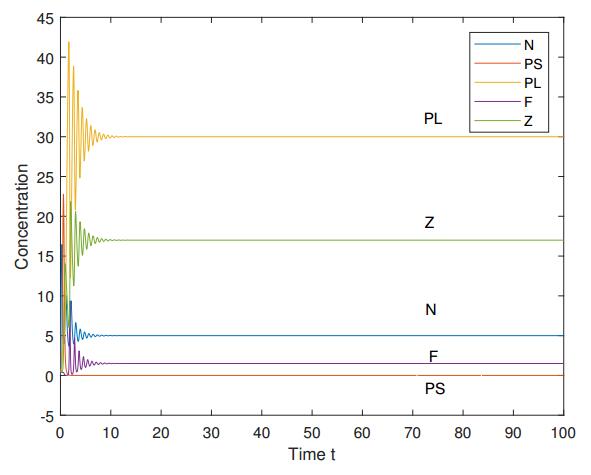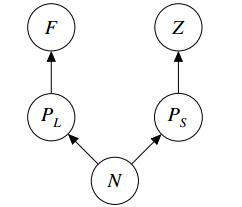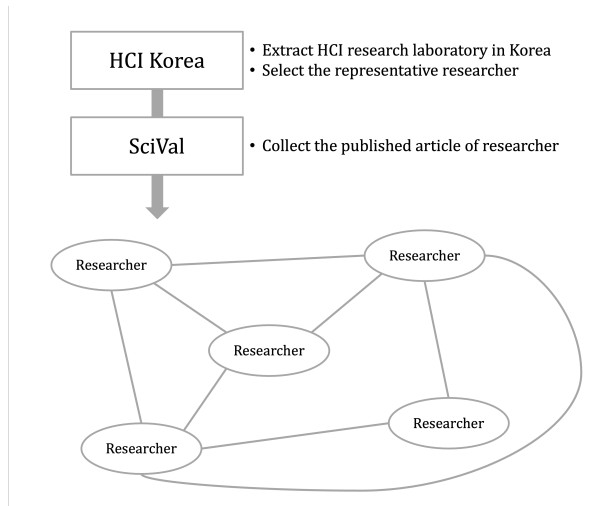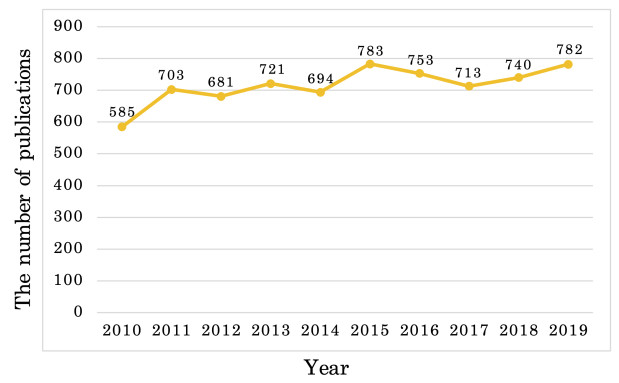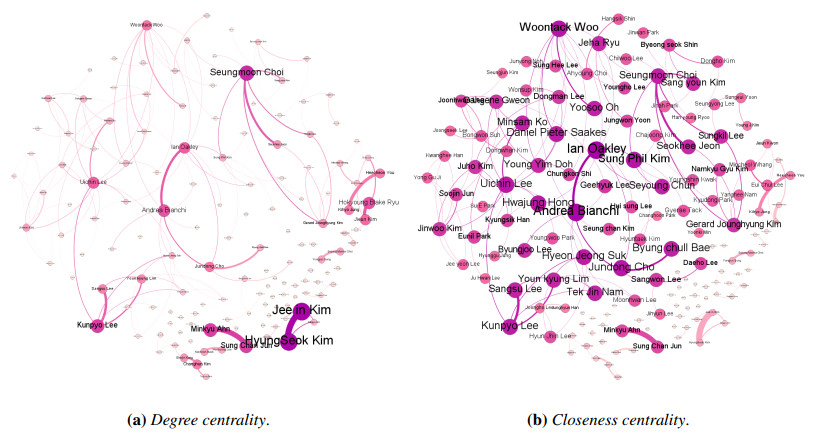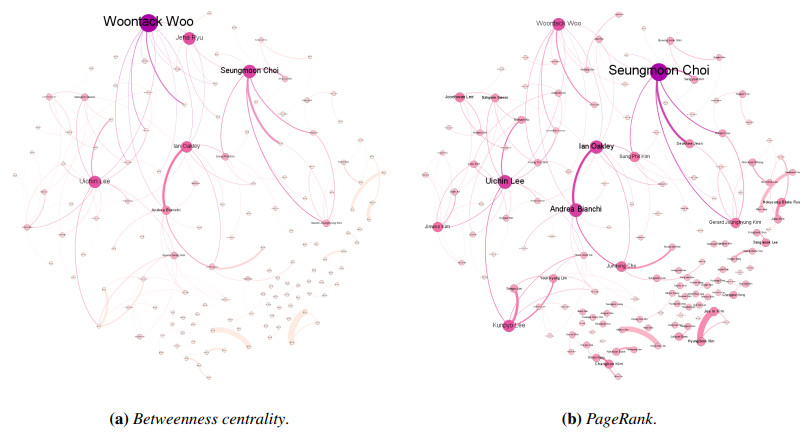1.
Introduction
It is important to determine survivors, which ultimately shape an ecosystem. However, answering this fundamental question depends on what we consider in a food web. There are studies on ecosystems that incorporate a different concept, like epidemics [10,11] and allelopathy [8].
Our work considers a microbial food web in the presence of parasitic fungi (e.g., chytrids). The importance of parasites in food webs has been emphasized in the literature; see [5,6,7]. According to a review paper [15] by Sommer et al, researchers have only recently considered parasites as one of the main drivers for phytoplankton succession. This review highlights the theory of mycoloop, a food chain conceived by Kagami and her team to explain the transfer of energy from large phytoplankton (Asterionella) to zooplankton (Daphnia) via parasitic fungi [1,2,3,4].
In this paper, we consider the following chemostat model based on Figure 1, where ′=d/dt.
The parameters of this model are described in Table 1.
Miki, Takimoto and Kagami formulated system (1.1) in their paper [9] and performed a local (steady-state) analysis to investigate the roles of parasitic fungi. We assume I=qN(0).
We focus on global dynamics and the limiting behavior of the solution
as t goes to infinity. In particular, we determine initial and parameter conditions for the solution to describe the survival and extinction of species PS, PL, F, and Z.
Let
It is easy to show the state space X and its interior int(X) are positively invariant.
The rest of this paper is organized as follows. In Section 2, we establish that our model is dissipative, from which the nutrient uniformly persists regardless of the input I. In Section 3, we study the boundary dynamics. Notably, we construct a Lyapunov function to determine the basin of attraction. An investigation on the local and global stability of boundary equilibrium points is presented in Section 4. In Section 5, we apply the uniform persistence theory [12,13,16] to prove the coexistence of species PS, PL, F, Z with F−Z link, i.e., γ>0. Section 6 deals with the dynamics of system (1.1) with the presence of parasitic fungi, but no F−Z link, i.e., γ=0. We conclude the paper with a discussion in Section 7.
2.
Dissipativity and nutrient persistence
First we show that our model system (1.1) is dissipative, as stated in the following theorem.
Theorem 2.1. Each solution of system (1.1) in X satisfies the following inequality:
Proof. Let c=1max{eP,fFeF}. We introduce the variable
It follows that u′≤q[N(0)−u]. Moreover,
for all t≥0. Passing the limit supremum to inequality (2.2) as t→∞, we get lim supt→∞u(t)≤N(0), which is inequality (2.1).
Theorem 2.2. The nutrient N uniformly persists in X.
Proof. Observe that
Hence N(t)≥δ>0 for t≥Tϵ, where δ=Iq+max(aS,aL)(N(0)+ϵ). This proves the uniform persistence of N in X.
3.
Boundary Dynamics
The ecologically relevant equilibrium points lie in the state space X. For our analysis, we focus on boundary equilibrium points, which have at least one zero coordinate. To this end, we let
From [14], our basic assumption is
That is, we assume phytoplankton species of small size, PS, is a strong competitor than that of large size, PL.
3.1. Boundary dynamics in the absence of parasitic fungi
When F≡0, system (1.1) becomes
and its food web is shown in Figure 2.
The conditions for the global stability of the equilibrium points of system (3.1) are stated in the next theorem.
Theorem 3.1. Let (H) hold and
For system (3.1), the following statements hold:
(i) If N⋆<λS, then EFS=(λS,N(0)−λS,0,0) is globally asymptotically stable (G.A.S.).
(ii) If λS<N⋆<λL, then EFSZ=(N⋆,P⋆S,0,Z⋆) is G.A.S., where Z⋆=aSN⋆−qb.
(iii) If λS<λL<N⋆<Iq, then EFSLZ=(λL,P⋆S,~PL,˜Z) exists and is G.A.S., where ˜Z=1b(aSλL−q) and ~PL=Iq−λL−aSaLP⋆S.
Proof. The statements are established as follows:
(ⅰ) We introduce the Lyapunov function given by
where ^PS=N(0)−λS, and c1,c2,c3>0 are to be determined. Then
Choose c1=1, c2=1, c3=1eP. Since
it follows that
Therefore, LaSalle's invariance principle implies that EFS=(λS,^PS,0,0) is G.A.S.
(ⅱ)Note that N⋆>λS implies that Z⋆>0. Define the Lyapunov function
We obtain
by using the equivalent expression
Hence, by LaSalle's invariance principle, EFSZ=(N⋆,P⋆S,0,Z⋆) is G.A.S.
(ⅲ) We construct the following Lyapunov function:
where
From the assumptions that NC=λL>λS=qaS and N⋆>λL, we see that PCL>0 and ZC>0. Thus
We conclude from the invariance principle that EFSLZ is G.A.S.
As a consequence of the above theorem, we obtain the following equivalent expressions:
Letting IF1=q(λS+P⋆S) and IF2=q(λL+λLλSP⋆S) with IF1<IF2, we conclude that
(ⅰ) if 0<I<IF1, then EFS=(λS,^PS,0,0) is G.A.S.
(ⅱ) if IF1<I<IF2, then EFSZ=(N⋆,P⋆S,0,Z⋆) is G.A.S.
(ⅲ) if IF2<I, then EFSLZ(λL,P⋆S,~PL,˜Z) is G.A.S.
The global stability of equilibrium points of system (3.1) is depicted in Figure 3.
3.2. Boundary dynamics in the absence of zooplankton
We consider the case that Z≡0. Then system (1.1) becomes
and its food web is presented in Figure 4.
From hypothesis (H), we see that PS is a better competitor for nutrient than PL. Obviously from the fact that parasitic fungi F only consume PL, it follows that EZS=(λS,^PS,0,0) with ^PS=N(0)−λS is G.A.S. Below we state the result without proof.
Theorem 3.2. Under assumption (H), EZS=(λS,^PS,0,0) is G.A.S. for system (3.2).
3.3. Boundary dynamics in the absence of phytoplankton species
For the case when PS≡0, system (1.1) becomes
with the corresponding food web provided in Figure 5.
Using the same Lyapunov functions V as defined in Theorem 3.1, we can prove Theorem 3.3 stated below. We thus omit the proof.
Theorem 3.3. Let hypothesis (H):0<λS<λL<Iq hold. Then the solution of system (3.3) satisfies the following statements:
(i) If 0<I<λLq(1+aLfFβ), then EPSL=(λL,N(0)−λL,0,0) is G.A.S.
(ii) If λLq(1+aLfFβ)<I<λL(1+aLfFβ)(q+βePγ(q+mZ)), then EPSLF=(ˉN,ˉL,ˉF,0) is G.A.S. Here ˉL=qfFβ, ˉN=Iq+aLˉL, ˉF=aLˉN−qβ>0.
(iii) If I>λL(1+aLfFβ)(q+βeFγ(q+mZ)), then the positive equilibrium G.A.S. He EPSLFZ=(ˆN,^PL,ˆF,ˆZ) exists and is G.A.S. Here ˆF=q+mZγeF, ˆN=βˆF+qaL, ˆZ=fFβ^PL−qγ>0, ^PL=I−qˆNaLˆN>0.
Taking IPS1=λLq(1+aLfFβ) and IPS2=λL(1+aLfFβ)(q+βeFγ(q+mZ)), the global stability of equilibrium points of system (3.3) is provided in Figure 6.
4.
Boundary equilibrium points of system (1.1) and their stability
From Section 3, there are seven distinct boundary equilibrium points of system (1.1) listed below :
where
Next we discuss the local asymptotic stability of the boundary equilibrium points in (4.1) with respect to system (1.1). Obviously E0 is unstable under hypothesis (H).
For the stability of ES, let N(0)<λS+q+mZePb. Then
and all of the eigenvalues of the Jacobian matrix of system (1.1) at ES are negative. Hence ES is asymptotically stable if N(0)<λS+q+mZePb.
For the stability of ESZ, if N(0)<λL+λLλSP⋆S, then
Thus, if N(0)<λL+λLλSP⋆S, then ESZ is asymptotically stable.
For the stability of ESLZ, consider
Therefore, ESLZ is asymptotically stable if (4.5) holds.
For the stability of EL, let N(0)<λL+qfFβ. Then
We conclude that EL is unstable in the PS direction and stable in F and Z directions.
For the stability of ELF, the assumption and ˉF>q+mZeFγ imply that
For the stability of ELFZ, consider
Hence ELFZ is asymptotically stable if aSˆN−bˆZ−q<0.
A summary of the results on the asymptotic stability of boundary equilibrium points of system (1.1) is provided in Table 2.
Now we present some extinction results in the next theorem.
Theorem 4.1. Suppose fF≤ePeF holds. Then the following statements hold.
(i) If N(0)<λS+q+mZePb, then ES=(λS,N(0)−λS,0,0,0) attracts each point (N,PS,PL,F,Z)∈R5+.
(ii) If λS+P⋆S<N(0)<λL+λLλSP⋆S, then ESZ=(N⋆,P⋆S,0,0,Z⋆) attracts each point (N,PS,PL,F,Z)∈R5+.
Proof. (ⅰ) Introduce the Lyapunov function
Choose c1=c2=1, c3=eFeP, and c4=1eP. Then
It folows from the invariance principle that ES is a global attractor.
(ⅱ) Define the Lyapunov function by
Let c1=1, c2=1, c3=eFeP, and c4=1eP. Then
By invariance principle, ESZ is a global attractor.
Remark 4.2: From our numerical simulation results, we conjecture that the equilibria ES and ESZ are G.A.S. even when fF>ePeF.
5.
Uniform persistence of system (1.1) with both parasitic fungi and an F-Z link, i.e., γ>0
In this section, we determine conditions for the species in system (1.1) to coexist by applying the theory of uniform persistence of Butler, Freedman and Waltman [12,13,16]. Since the boundary dynamics for F≡0, Z≡0, and PS≡0 are discussed in Section 3 and the acyclic conditions are easy to verify, it remains only to verify that WS(Mi)∩Int_(R5+)=ϕ for each boundary equilibrium Mi.
Consider the operation diagram in Figure 3 and the case that I>IF2=λL(q+aLP⋆S). From the equation for F in system (1.1), the invasion condition for the boundary equilibrium ESLZ=(λL,P⋆S,~PL,0,˜Z) is FF>0. That is,
where ~PL=Iq−λL−aSaLP⋆S>0, ˜Z=1b(aSλL−q)>0, and P⋆S=q+mZePb (See 4.2).
Lemma 5.1 below shows that inequality (5.1) is equivalent to
Next, we consider the operation diagram in Figure 6 and the case that
Similarly, the equation for PS in system (1.1) provides the following invasion condition for the boundary equilibrium ELFZ=(ˆN,0,^PL,ˆF,ˆZ) :
where ˆF=q+mZγeF, ^PL=I−qˆNaLˆN>0, ˆZ=fFβ^PL−qγ, and ˆN=βˆF+qaL (See (4.2)).
In Lemma 5.1, we also prove that inequality (5.3) is equivalent to
We state the lemma below.
(i) Inequalities (5.1) and (5.2) are equivalent.
(ii) Inequalities (5.3) and (5.4) are equivalent.
(iii) If ePeF>fF, then I3>I2.
Proof. (ⅰ) Equivalence is established by substituting ~PL=Iq−λL−aSaLP⋆S and ˜Z=1b(aSλL−q) into inequality (5.1). We have
This proves (ⅰ).
(ⅱ) First note that ˆN=βaLˆF+λL>λS implies aSˆN−q>0. We have
Using the equalities
we express I3 as
Next, by the equivalence
it follows that IPS2=λL(1+aLfFβ)(q+βˆF)<I3. Hence (ii) is established.
(ⅲ) Expanding I2 and I3, we have
and
If eFfF<eP, then aSλLbfFeF>aSλLePb. Thus, it is easy to verify that I3−I2>0.
We establish the coexistence of species in the next theorem wherein the proof follows directly from the above lemma.
Theorem 5.2. The following statements hold:
(i) If I2<I<I3, then system (1.1) is uniformly persistent and the positive equilibrium is globally asymptotically stable.
(ii) If I>I3, then PS(t)→0 as t→∞.
Using the parameter values q=1, aS=0.8, aL=0.5, λs=1.25, λL=2, b=1, eP=0.5, eF=0.4, β=1, γ=1, fF=0.6, and mZ=0.5, we have I2=11.35 and I3=66.92. By setting I=20, we obtain a numerical simulation of statement (ⅰ) as depicted in Figure 7. Letting I=80, a numerical simulation for statement (ⅱ) is shown in Figure 8.
6.
Dynamics with parasitic fungi, but without an F-Z link
When γ≡0, system (1.1) becomes
and its food web is shown in Figure 9.
Theorem 6.1. Let (H):0<λS<λL<Iq hold.
(i) If P⋆S>^PS, then ˜ES=(λS,^PS,0,0,0) is G.A.S., where ^PS=I−qλSaSλS and P⋆S=q+mZePb.
(ii) If P⋆S<^PS and λS<N⋆<λL, then ˜ESZ=(N⋆,P⋆S,0,0,Z⋆) is G.A.S., where N⋆=Iq+aSP⋆S and Z⋆=aSN⋆−qb.
(iii) If P⋆S<^PS and NC<λL<N⋆, then ˜ESLZ=(λL,P⋆S,P⋆L,0,ˆZ) is G.A.S., where P⋆L=I−qλL−aSP⋆SλLaLλL.
(iv) If P⋆S<^PS, N⋆>λL, and NC>λL, then ˜EC=(NC,PCS,PCL,FC,ZC) is G.A.S., where PCL=qfFβ, PCS=q+mZePb=P⋆S, NC=Iq+aSPCS+aLPCL, ZC=aSNC−qb, and FC=aLNC−qβ.
Let ˜I1=qλS+aSPCSλS, ˜I2=qλL+aSPCSλL and ˜I3=qλL+aSPCSλL+aLPCLλL. Then ˜I1<˜I2<˜I3. As a consequence of Theorem 6.1, the following statements hold.
(ⅰ) If 0<I<˜I1, then ˜ES is G.A.S.
(ⅱ) If ˜I1<I<˜I2, then ˜ESZ is G.A.S.
(ⅲ) If ˜I2<I<˜I3, then ˜ESLZ is G.A.S.
(ⅳ) If I>˜I3, then ˜EC is G.A.S.
The global stability of system (6.1) is given in Figure 10.
Proof. (ⅰ) Note that ^PS>P⋆S⇔N⋆>λS⇔Z⋆>0. We introduce the Lyapunov function
Then
from the assumption P⋆S>^PS. Thus ˜ES is G.A.S. by invariance principle.
(ⅱ) Note that ^PS>P⋆S ensures that Z⋆>0. Introduce the Lyapunov function
Then, by the assumptions P⋆S<^PS and N⋆<λL, we have
Therefore ˜ESZ is G.A.S. by invariance principle.
(ⅲ) Define the Lyapunov function
Then
Using the assumptions P⋆S<^PS and NC<λL<N⋆, and the equivalence below
we have ∙V≤0. Hence ˜ESLS is G.A.S. by invariance principle.
(ⅳ) Observe that the assumptions P⋆S<^PS, N⋆>λL, and NC>λL imply ^PS>0, P∗L>0, and FC>0, respectively. By introducing the Lyapunov function
we obtain
Therefore it follows from invariance principle that ˜EC is G.A.S.
7.
Discussion
In this paper, we study an aquatic ecosystem with five species : a single nutrient resource N (Phosphorus), the small phytoplankton PS, the large phytoplankton PL, the zooplankton Z, and the parasitic fungi F. Both PS and PL consume N. In the food web (see Figure 1), the zooplankton Z only consumes the small phytoplankton PS but the large phytoplankton PL is inedible to the zooplankton. In the absence of zooplankton, we assume that the small phytoplankton PS is a better competitor than the large PL in the exploitative competition for nutrient. With the presence of parasitic fungi F, we consider two cases : the food web with an F−Z link and that without an F−Z link. In Section 3, we first study the boundary dynamics of the food web, i.e., the population dynamics under the assumptions that F≡0, Z≡0 and PS≡0. We then employ Lyapunov functions to establish the results of global stability as the nutrient input I varies. Section 4 deals with the determination of conditions for the local stability of boundary equilibrium points of system (1.1) and the proofs of several partial results on the extinction of species. In Section 5, with the well understood information of boundary dynamics proven in Section 3, we establish the uniform persistence of the food web. Section 6 is devoted to determine conditions for the global stability of species in the system of food web without an F−Z link.
Now we discuss the role played by parasitic fungi in the coexistence of species in the food web. Recall that, in the absence of parasitic fungi, from Figure 3, coexistence of species occurs when I>IF2. When parasitic fungi are present in the food web, we consider two cases: one with an F−Z link and another without an F−Z link. In the case without an F−Z link, coexistence of species occurs when I>˜I3 (see Theorem 6.1), whereas in the case with an F−Z link, coexistence of species occurs when I2<I<I3 (see Theorem 5.2). A comparison of the three quantities IF2, ˜I3, I2 shows that
where
In view of the above, the best case for the coexistence of species of the food web is when I>IF2. That is, coexistence of species occurs if there is no parasitic fungus. In the case that parasitic fungus is present and there is no F−Z link, coexistence of species occurs if I>˜I3. With the presence of parasitic fungi and an F−Z link, we have coexistence in the parameter region I2<I<I3. From our numerical simulation (see Figure 8), we observe that, if I>I3, then the small phytoplankton PS goes to extinction.
Finally, we note that in [9] the authors discuss the role of parasitic fungi in zooplankton biomass at steady states. Their conclusion is that the presence of an F−Z link can benefits large phytoplankton and strengthens competition between small and large phytoplankton reducing material transfer from smaller phytoplankton to zooplankton. While our analysis shows that without F−Z link if IF1<I<IF2 then zooplankton, fungi, small phytoplankton coexist; if I>IF2, the zooplankton, fungi, small and large phytoplankton coexist (see Figure 3). However, with F−Z link, the system (1.1) is uniformly persistent if I2<I<I3 (Theorem 5.2). From the inequality IF2<I2<I3, it is easier to obtain coexistence when there is no F−Z link.
Acknowledgments
The first author would like to acknowledge the financial support of the Department of Science and Technology-Science Education Institute (DOST-SEI), through the Accelerated Science and Technology Human Resource Development Program-National Science Consortium (ASTHRDP-NSC). The second author acknowledges the support of Ministry of Science and Technology (MOST), Taiwan and National Center of Theoretical Science, Taiwan.
Conflict of interest
The authors declare there is no conflict of interest.
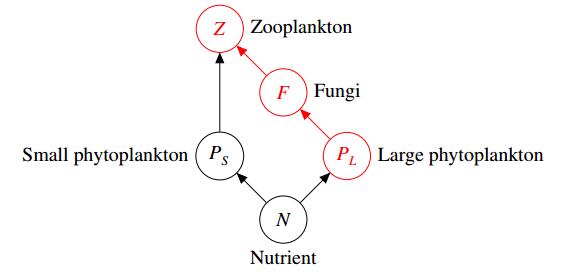









 DownLoad:
DownLoad:
